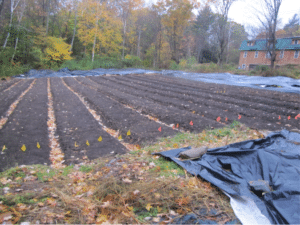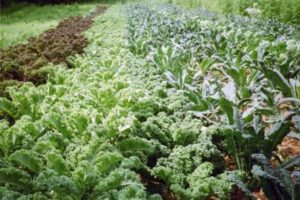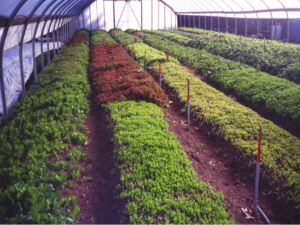Small Scale No-Till Vegetables at Seeds of Solidarity Farm
by Brian Caldwell and Ryan Maher
Mulches and tarps combine to build active soils and suppress weeds.
In 1996, Ricky Baruc and Deb Habib moved to 30 acres of forested land in Orange, MA. Roughly 5 acres of woods over uneven, rocky soil were logged and cleared in preparation for a house, farm and teaching center. The couple had met about 10 years previously at the New Alchemy Institute on Cape Cod, which was a cutting edge sustainability research organization. The Institute explored ways for people to produce food and energy in their living spaces, notably growing Tilapia fish and vegetables in greenhouses integrated into homes. After NAI, Ricky farmed commercial organic vegetables in central New York for several years, but was disenchanted with the mechanization, pace, and scale. He went on a peace pilgrimage with Deb in 1994, and the two formed a vision of a teaching center that combined positive actions with promoting a deep understanding of peace as a way of life.
Seeds of Solidarity Farm includes both a working farm and a teaching center. Local young people attend the SOL (Seeds of Leadership) garden program on the farm in summer, building awareness and confidence while growing and donating food. The creation of dozens of school gardens and recently a program to teach food production to prison inmates are also parts of the education side.
The farm embodies this passion for right livelihood and positive practice. It uses energy from renewable sources whenever possible, including biodiesel vehicles and solar irrigation and refrigeration. The focus here, for the purposes of this article, is it’s unique no-till crop production system.
Over the past 20 years, Ricky and Deb have created a no-till method of growing commercial vegetable crops that relies on using locally available materials to feed worms and build soil. They have transformed their acidic cleared forest soil, which now has a thick layer of nutrient-rich topsoil. Importantly, their methods can be used by small farmers and gardeners in both urban and rural situations. It does not scale up easily, but it scales down readily. Seeds of Solidarity’s motto is, “Grow food everywhere!”
In the most basic form, their soil-building steps to establish vegetable beds are:
- Cover the planting area with cardboard pieces, overlapped along the edges. By sourcing through local furniture supply stores, they get large sheets. This is preferably done in fall. Cardboard can be placed over tilled soil or sod.
- Add a layer of weed-free mulch hay on top of the cardboard to hold it in place and add organic matter.
- In spring, make holes in the cardboard-mulch to accept transplants. Remove about a quart of soil and add a quart of mature compost.
- Transplant into the compost.
By the following spring, the cardboard and hay have mostly broken down into the soil. Soil is shoveled out of the pathways and thrown onto the planting beds about every other year, adding to the rich soil there. Raking it smooth results in raised beds, for better crops when rainfall is excessive, a frequent situation in recent years. Ricky uses 3.5-4 foot wide beds, with 1 foot pathways. Cardboard and hay are applied on top of the beds for several years, with cardboard edges coming down into the pathways to help suppress weeds. Rain tends to form the cardboard to the shape of the raised beds.
Organic inputs into this system are high. A 12” layer of hay mulch equates to about 10 tons per acre. One quart of chicken manure compost per plant is 7 cubic yards per acre at a 3’ by 3’ plant spacing, or 28 cubic yards at 18” by 18”. The cardboard itself also provides organic matter and nutrients to the soil. By avoiding tillage and investing in practices that add organic matter, the system creates ideal conditions for earthworms and a healthy soil biology. Soil temperatures are moderated with these mulching conditions and moisture is conserved. The need for weed control is almost zero in the cardboard + compost + hay mulch system and productivity is high. Since Ricky does most of the crop production work himself, reduction of weeding time is important. This system has shown to work well for transplanted crops, like their brassicas, tomatoes, cucurbits and hot peppers.
Other main crops include salad greens (grown mostly in hoophouses) and garlic and more recently corn and wheat staple crops. Seeds of Solidarity Farm includes five hoophouses in addition to the vegetable fields. Their land was so uneven that they brought in sand to level areas for the hoophouses, and built new soil right over it. The hoophouses extend the harvest season and allow for intensive production of salad greens, Asian greens, spinach, tomatoes, and peppers. All crops are sold at a farm stand on site.
Ricky and Deb wanted to document and share results from their mulching practices, so they submitted a NESARE Farmer/Rancher grant proposal along with Rachel Scherer (Heritage Fields Farm) and Christopher Picone (Fitchburg State College). It was funded, and they ran a replicated study on their farm in 2011-12. The project was implemented on an area that had been cleared but had not yet been farmed. It included four treatments, each replicated three times. They were 1) undisturbed, unmulched, no crop control; 2) 12” of mulch hay; 3) 12” of mulch hay over 1” of newsprint; and 4) 12” of mulch hay over ¼” of corrugated cardboard. Each treatment covered a 3’ x 50’ bed. Transplanted brassica, cucurbit, and tomato crops were grown over 2 seasons in treatments 2-4. For each transplant, a shovelful of soil was removed and replaced with mature chicken litter compost. At the end of the study, many measures of soil fertility had increased dramatically in the cardboard + hay mulch treatment, relative to the unmulched, no crop control (Table 1).
| Sample | pH | Organic matter | Cation exchange capacity | Phosphorus | Calcium |
| Cardboard + hay soil | 6.9 | 12.5 | 27.9 | 231 | 3043 |
| Control soil | 5.7 | 10.8 | 17.6 | 4 | 325 |
| Compost | 7.0 | 14.4 | 37.2 | 622 | 3339 |
Table 1. Fall 2011 soil and compost analysis
The mulch hay alone and mulch hay + newspaper treatments produced intermediate soil test numbers. Results showed very large increases in pH, organic matter and cation exchange capacity for only a two-year period. They reflect heavy inputs of organic materials, lack of tillage, and the metabolic and mixing functions of earthworms and other organisms. Control soil (cleared forest) organic matter levels were very high to start with. Note that the cardboard plus hay values are intermediate between the control soil and compost. This is likely the result of placing compost into the crop planting holes. It is likely that after two years of the cardboard + hay treatment, crop yields are maximized and would respond little to further increases in soil nutrients and organic matter.
A question that arises from the high soil test numbers under this program is, could the inputs be dialed back after a few seasons? Could compost and hay mulch be reduced or eliminated once the soil biology is revved up, with no detrimental effect on yields or weeds? In fact, Ricky has switched to covering cardboard with a light dressing of horse manure compost, just enough to hold it down. He feels that once his soil is built up, this is sufficient for good production. Researchers at Cornell and other universities are also looking at this question.
More recently, Ricky has been implementing another novel no-till practice, the use of tarps made of tough, durable silage plastic. Tarps are placed over fields during periods of about 6 weeks when they have no cash crop, then removed intact before the next planting. The function of the tarps is to kill weeds and create an environment, which allows earthworms and other soil organisms to eat crop residues while suppressing any weed growth, essentially prepping the soil for the following crop. The tarps also warm the soil in spring. This practice once again uses no tillage. The heavy plastic can be reused for years before being recycled. An additional feature of tarped areas is that no water infiltrates them and none evaporates from the soil. Thus, leaching of nutrients is minimized. There is some “parking lot effect” in which rainwater accumulates just off the tarp edges, so tarps cannot be too large. Typically they are 25 or 40 feet wide and 100 feet long. The tarps greatly reduce the labor needed to prepare beds for planting. There is no need to remove residues or hoe out any weeds—Ricky removes the tarp after the proper period, adds compost if needed, and plants into the mulch. Tarps also increase flexibility for planting cover crops and small seeded crops (mulch may need to be raked off for these), which are difficult to grow in cardboard-mulched beds. “They give you so much freedom!” says Ricky.
The tarps have been especially useful to control weeds in the farm’s hoophouses used to grow salad mix. The residues and weeds there are killed and controlled in only half the outdoor time, 2-3 weeks, due to warmer conditions. Ricky uses 4’x 96’ strips of tarp to manage individual beds in the hoophouses.

In the fall of 2015, tarps had just been removed from these beds to plant garlic. No mechanized bed-forming here, just soil built up with cardboard and mulch! (photo: Caldwell)
In outdoor fields, a typical sequence might proceed as follows: Cardboard, which is in limited supply, is put down in fall or early spring and covered with a thin layer of horse manure compost (inexpensive, not so nutrient rich as chicken manure compost). The following May or early June, this is planted to squash, brassicas, or heirloom corn. Residues and weeds from these beds are then scythed down after harvest, and covered with tarps. Over 6 or more weeks, weeds die and residues decompose. If the timing is right, tarps can be removed in October or November, and garlic planted.
Temperature and moisture management are important elements of these no-till approaches. In spring, when tarps are removed from the raised beds, the soil is warm for good early growth of salad mix, spinach, etc. In summer, however, the even temperatures under the cardboard and hay mulch are beneficial for most crops. Similarly, the impervious tarps moderate planting bed moisture in spring, reducing waterlogging in wet seasons and holding in moisture when it is dry. Lack of tillage and a thick layer of mulch conserve moisture for summer crops. These factors plus the use of hoophouse structures will likely play important roles in a future with greater weather extremes.
Ricky says that cardboard mulching and tarping are keys to success with no-till organic vegetable production. These two tools unlock powerful soil allies—earthworms—to help the farmer reduce labor and build soil, with remarkable results. Seeds of Solidarity Farm has added a few more pieces towards solving the long term puzzle of sustainable living in the Northeast.
Brian Caldwell and Ryan Maher research reduced tillage for organic vegetable systems at Cornell University. For questions on this article, contact Ryan Maher at ryan.maher@cornell.edu.
Reduced Tillage Project
Reduced tillage takes many forms. This story is the 5th in a series featuring organic vegetable growers that have transitioned to reduced tillage systems toward greater farm sustainability. Experienced growers at diverse scales are developing strategies for tackling weeds, managing rotations, and integrating cover crops while minimizing soil disturbance. Look for past and future SFQ issues to learn the practices that are helping these growers build better soils. Visit the Small Farms Reduced Tillage Project webpage or contact Ryan Maher of the Cornell SFP for more information on this project, ryan.maher@cornell.edu



